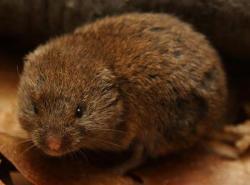The most elusive of these are the voles. Moles are often blamed for their damage, but moles are carnivores. They do a lot of damage, but they don’t eat plants. While there are over 100 species of voles, only seven species are of importance to growers in North America. Two, the Meadow vole and the Pine vole, are widely distributed . These are the ones that I battle, and they will be the focus of this discussion. Both at first glance resemble a large mouse with a darker coat.
The Meadow vole (Microtus pennsylvanicus) most closely resembles a mouse and is often called a field mouse. They live mostly above ground, but they will use mole tunnels when available. They can be identified by their runways, which are narrow trails through grass that are littered with droppings and grass clippings. A vegetable grower is mainly concerned with potatoes, both Irish and sweet, as they will follow ground cracks or the stem of the plant and feast on the potatoes. They will also sniff out and eat shallow bulbs and tubers, so flower growers are even more subject to their depredations. Orchardists have a greater problem, because voles like to girdle trees at the soil line. Fortunately, because these voles spend most of their time above ground, most of the controls for rats also work for meadow voles. They are a favorite food for barn owls, saw-whet owls, and screech owls. A small population of any one of these will keep them in check. Small hawks also hunt them, but the nocturnal owls are much more effective. A good hunting cat or two will also be effective. Traps and rodenticides will also work as a last resort. Good sanitation practices, which involve the elimination of debris that can used as nesting sites, are also effective. Wrapping the trunks of trees with hardware cloth is effective. It can also be used to isolate (fence in ) a planting area.

The Pine vole (Microtus pinetorum) is smaller. It has very small ears that are hidden by its fur and very small eyes. Its most distinguishing characteristic is its very short tail, almost a bob-tail. The Pine voles live almost entirely underground, where they drill a network of tunnels 2-3 inches below the surface. Your first evidence of their presence is usually a mound of dirt on your lawn that appears overnight and resembles a mini-volcano. Again, the main problem for a vegetable grower is their appetite for potatoes, but they also will eat the roots of plants and disturb other plants with their tunneling. I have had them come up under cantaloupes and completely hollow them out. In the orchard, they eat the bark off tree roots, killing or severely stunting the plant before surface indications are present. Of course, they also love the bulbs and tubers of ornamentals. A small grower can fence in a small patch, using hardware cloth extending about a foot deep in the soil. Because the voles are mostly hidden, controls are mainly limited to the use of traps and rodenticides. They do use their tunnels over and over, so after you find the tunnels you will have access to them. You can take out a section of earth large enough to expose the tunnel and permit the use of a mouse trap.

http://www.ces.ncsu.edu/nreos/... http://icwdm.org/handbook/rode... http://nysipm.cornell.edu/fact...
| Thread Title | Last Reply | Replies |
|---|---|---|
| Great Info by Joannabanana | May 18, 2016 7:03 PM | 3 |
| Voles: All Bad? by SunnyBorders | May 14, 2014 7:11 PM | 0 |
| difference between a mole and a vole? by Frillylily | May 14, 2014 12:44 PM | 7 |
| Useful information by Newyorkrita | May 12, 2014 7:14 PM | 0 |